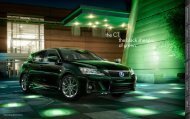Table of Contents
Table of Contents
Table of Contents
You also want an ePaper? Increase the reach of your titles
YUMPU automatically turns print PDFs into web optimized ePapers that Google loves.
A large theme in the work <strong>of</strong> New York-based artist Joe Fig is trying to get at the truth <strong>of</strong> how contemporary art<br />
is made. Along with audio interviews with artists like Ryan McGinness, Chuck Close and Eric Fischl, he creates<br />
painstakingly detailed, perfectly scaled miniatures <strong>of</strong> their studios. His table sculptures series focuses specifically<br />
on painting tables—the space that the artists use to mix their paints and store their tools. Fig’s work has been<br />
compiled in the book Inside the Painter’s Studio, now in its fifth printing. Here he answers some questions about<br />
how the project got started and what he has learned over the course <strong>of</strong> it.<br />
What motivated your interest to learn about, and then subsequently depict, artists’ workspaces?<br />
I’ve always been interested in other people and how they spend their days. People spend so much time at work, I’m<br />
curious about their day-to-day routines. After years <strong>of</strong> making art I was back at grad school and realized I’d been an<br />
artist for 10 years and that this was my pr<strong>of</strong>ession. I wanted to get a better understanding <strong>of</strong> the real day-to-day<br />
practicalities <strong>of</strong> the life <strong>of</strong> the contemporary artist. I also thought that if I understood how other artists work and how<br />
they set up their studios, it would make me a better artist.<br />
What was behind the decision to render them in diorama form?<br />
I had been a painter, but I also had an interest in sculpture. By creating these sculptures in miniature it gives the viewer<br />
a sort <strong>of</strong> God’s eye or voyeuristic perspective, which is quite different from rendering something on a flat surface in<br />
paint.<br />
What’s your process for creating these sculptures, and how long does it take to build one?<br />
I start with a visit to an artist’s studio and then conduct a formal interview, which I record. I then photograph and<br />
measure everything in the studio. Armed with all this reference material I decide on the composition and size and just<br />
begin building. The time they take varies. From the initial interview to finality can take from three to six weeks.<br />
There are some romantic notions about how art gets made. Was part <strong>of</strong> the concept behind this work to show that being<br />
a successful artist is a job, one that requires a workspace and tools, much like other jobs?<br />
Exactly. And I found that the most successful artists were successful because they worked the hardest. It’s really no<br />
different than any other pr<strong>of</strong>ession.<br />
Were most artists receptive to having their studios depicted? Did you encounter any instances <strong>of</strong> them wanting to<br />
preserve a sense <strong>of</strong> mystery?<br />
If the artist agreed to allow me into their studio they kind <strong>of</strong> gave up any mystery, as I would really pick through<br />
everything in their space. It is in the details that I find that the artist’s personality really comes out. I would make a<br />
concerted effort to investigate the corners <strong>of</strong> the studio, searching for any significant, and maybe forgotten, revealing<br />
items.<br />
Did you find that most artists felt positively towards their studios, or did they share the same dread or resentment that<br />
many people feel towards their <strong>of</strong>fices or places <strong>of</strong> work?<br />
The artists I’ve interviewed, which have been over 60 so far, love their studios. There is no other place they’d rather be.<br />
If there was any thing they didn’t like, it was mostly the need for more space. Though there was one artist, Malcolm<br />
Morley, who mentioned how he gets stage fright sitting in front <strong>of</strong> a painting in progress and he needs to be coaxed<br />
into the studio, <strong>of</strong>ten by audio books or salsa music.<br />
In your research, did you come to see a connection between the condition that the art was made in and the art itself?<br />
Again it depends on the artist. Chuck Close says that once his back is to a room he can be anywhere. Though for James<br />
Siena, his work is directly impacted by the size <strong>of</strong> his study (small, and located in New York’s Chinatown). The area<br />
is condensed, his studio is condensed and his work is condensed.<br />
In visiting all these different artists’ studios, were you struck more by their commonalties or by what set each <strong>of</strong> them<br />
apart?<br />
Each artist is unique in that their work requires certain requirements (space, light, sound, no sound, a drawing section,<br />
a spray paint section, etc.), so each artist adapts a space to his own needs. In a way, it’s no different than a mechanics<br />
shop. You need the space and the right tools, and maybe some loud music.<br />
joefig.com<br />
Spread 1: Depiction <strong>of</strong> Gregory Amen<strong>of</strong>f's workspace. Spread 2: Clockwise, depictions <strong>of</strong> the work spaces <strong>of</strong> Billy Sullivan, Karen Davie, Chuck Close and Inka Essenhigh.

















